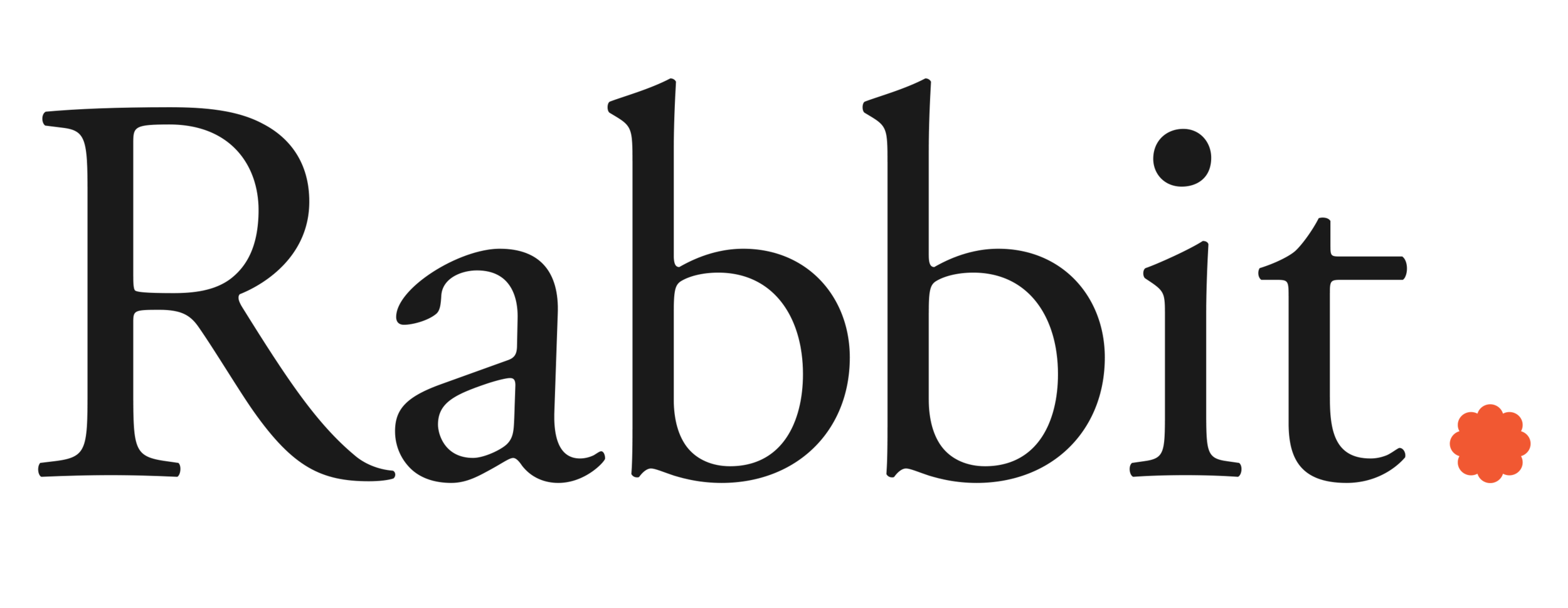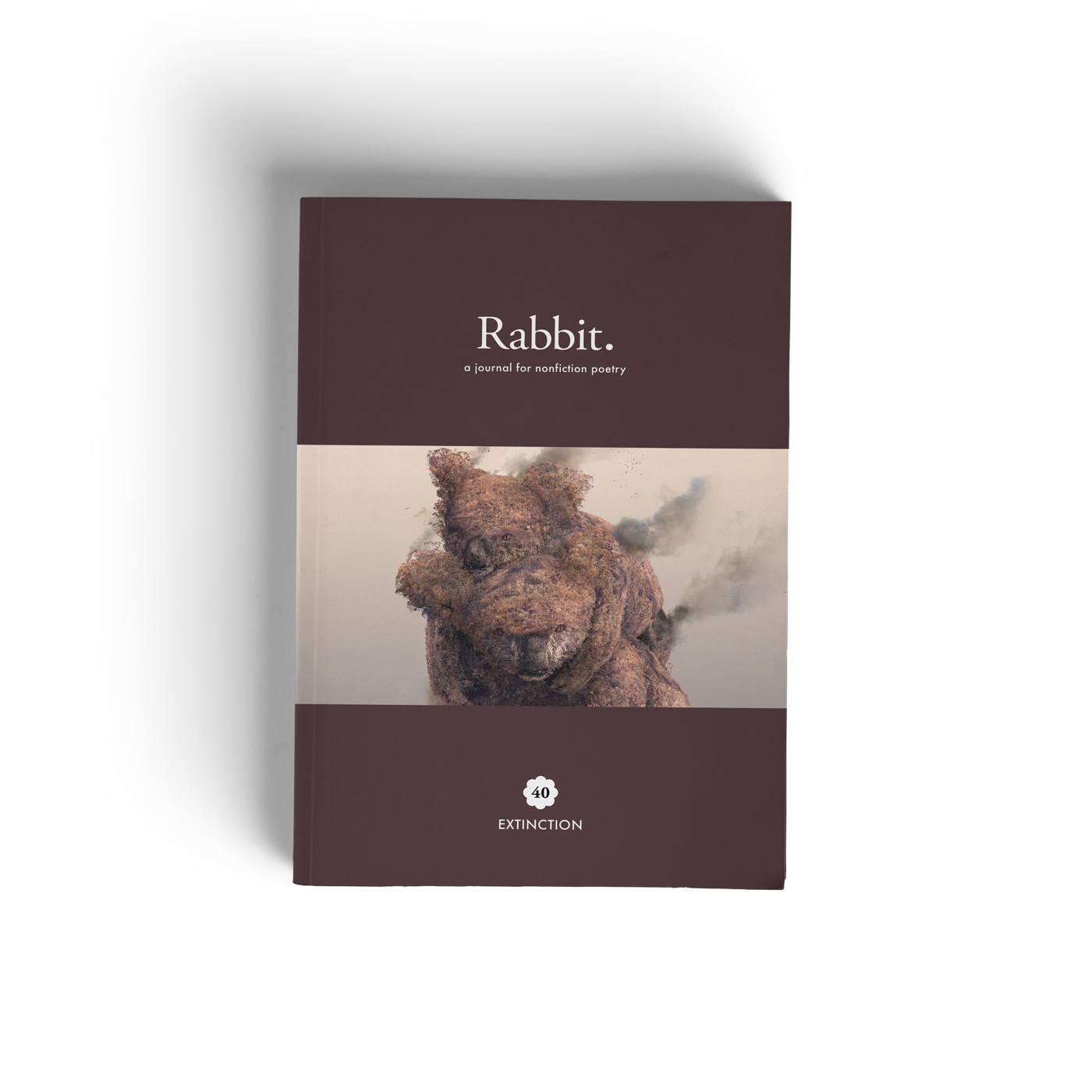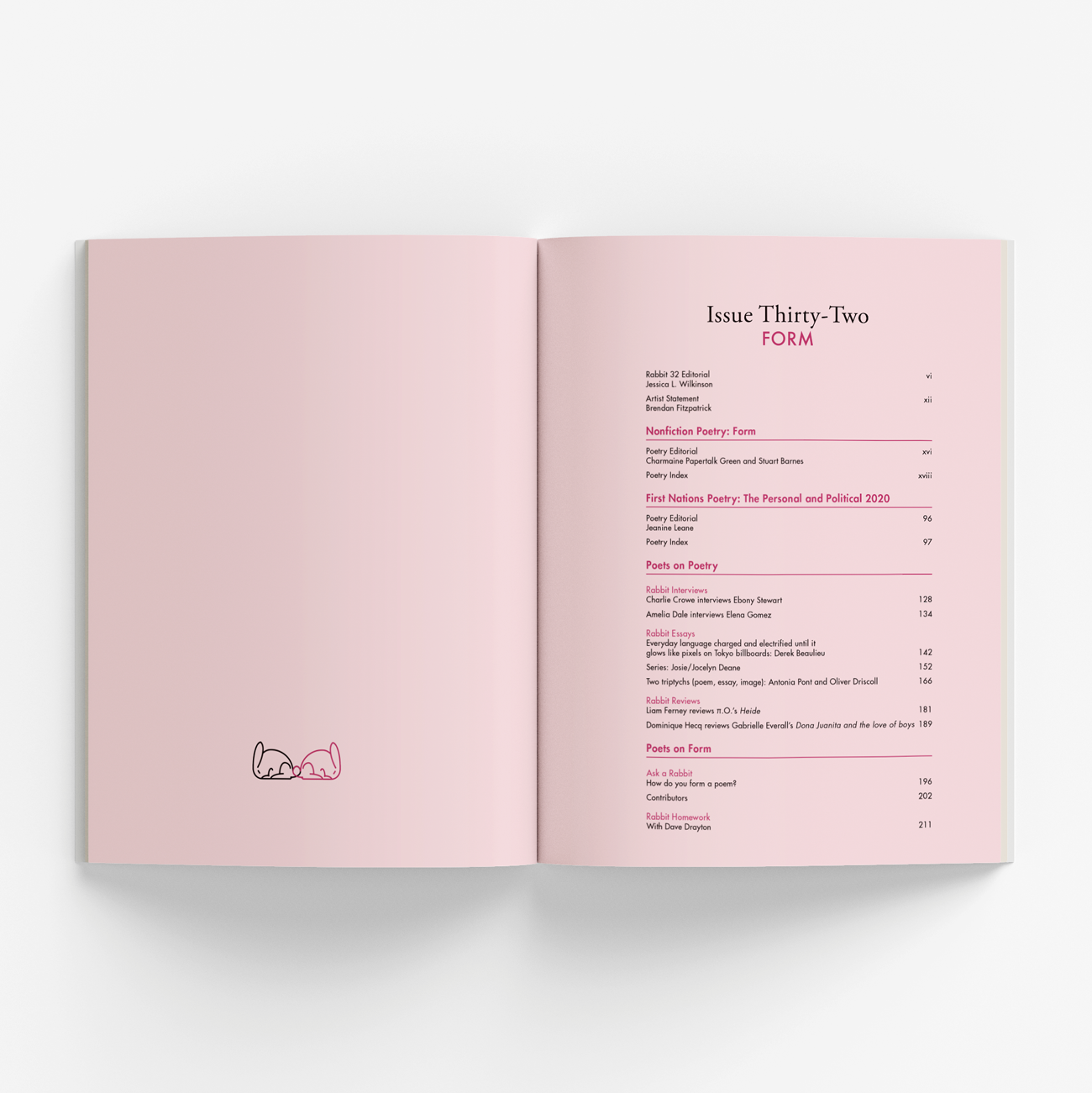RABBIT 37 – Collaborations


RABBIT 37 – Collaborations
‘But when a work is complete, that achievement—the solving of some creative problem with other minds—can bring a thrill that surpasses those that accompany any solo endeavour. Perhaps this is because cooperation is another kind of achievement?’
Dear Jacqui,
We’re into the third week of January and I’m relieved to finally say good riddance to 2022. When we conceived of this issue back then, I remember craving togetherness, sharing, dialogue—anything to lift me out of the fog of those months, to get my creative brain working again after COVID had rendered me slightly useless. Collaboration generates all of those things, sparks an energy that can’t be gained alone. Collaboration also prompts me, personally, to experience a broad spectrum of emotions—I am only now recognising this, as I muse on this issue’s theme. To elaborate: my first response to any invitation to collaborate is usually fear—I’m not joking! What I mean is that I dread letting my collaborator down: I’m too slow at thinking, writing, doing; I won’t meet the smartness of their efforts; my contribution will be thin. It is funny that those are always my first thoughts, because when the wheels start to turn, those fears recede and something unexpected, bracing, emerges; something better than I could have predicted on my own. Perhaps the fear is a fuel to get me going... But when a work is complete, that achievement—the solving of some creative problem with other minds—can bring a thrill that surpasses those that accompany any solo endeavour. Perhaps this is because cooperation is another kind of achievement?
Dear Jess,
Yes, I can relate to those fears about collaboration, and they can make me (over?) cautious about proposing or accepting opportunities to collaborate. But I agree that the achievement, in creating the collaborative relationships as well as the work itself, seems magnified. Music tends to be a more collaborative art form, and the thrill of successful collaboration reminds me of singing or playing in a group (even at amateur levels) and those moments when it suddenly seems to crystallise into something transporting. When the submissions for this issue came in, though, I had to think about what collaboration was before I could think about what made it effective. Can one ‘collaborate’ with someone who is no longer alive, by responding to or remixing their work? Is it ‘collaboration’ if one artist responds to another’s work with their agreement, but that only occurs in one direction? Can a non-human entity collaborate? I discovered I had some firm but unexamined views, and asked myself if I was being unnecessarily rigid, or perhaps lacking imagination? My touchstone for defining collaboration became the sense of the ‘co-’—of two or more artists (or entities) acting together, working mutually. That said, we have included some pieces that push at the edges of that idea, and mutuality is approached and expressed in many different ways across the poems in our selection.
Dear Jacqui,
Defining ‘collaboration’ can feel a bit like gatekeeping. On the other hand, an ‘open-to-any-and-all’ approach can annoy (me, at least!). There has to be some line, even if it’s flexible, porous, contestable. We talked about this ‘line’ for us, how it informed some of our decisions. There were a lot of great poems we didn’t select because we felt that they fell too wide of the line. One of the words that arose between us was ‘consent’—of both parties entering the collaboration space willingly. The question of ‘dead collaborators’, then, recedes when they are not active players, though we read several excellent poems in the submissions pile along those lines, and which were perhaps more collage, pastiche, cento, than they were collaboration. Our conversations also turned to the idea of purposeful collaboration—the sense that the fact of the collaboration added something to the work. Our final selection, I think, showcases, among other things, that ‘range of purpose’. We included collaborative works that allow two or more perspectives to merge into a collective one (such as ‘Vorescape’ by MA|DE, ‘extract absism’ by Barnes & Hetherington, ‘Some Popular Australian Mistakes (22 Thoughts on a Dead Bullock)’ by Crawford & Collis or ‘The Most Alive Thing’ by Foong & Collyer) as well as those that demonstrate a cooperative ‘working through’ a problem (‘A line sent’ by Barton & Gaskin, ‘On The Picket Line With You’ by Chłopicki & Radievska); there are works that emerged through call-and-response methods, enabling connection and exchange between two or more collaborators, as well as pieces that reveal the opportunity that collaboration opens for play (‘Sending love love’ by Rendle-Short & Eades, or ‘Siegel zeros’ by Cully-Hugill, Hathi, Nikolic & Yang).
Dear Jess,
Some of the work was very playful, with collaborators ‘bouncing off each other’ in really lively ways. I also enjoyed discovering that Japan has traditionally collaborative forms including renga and the more playful renku, and we have included an example of each (‘Words with Friends’ by Karan & Arnold, and ‘Post Industrial SMS Renku’ by Sullivan & Gili). Speaking of Japan, the examples of collaborative translation we chose were both translated from Japanese, and distinguished from translation in general by two translators working together (Magee & Kinoshita translating a haiku by Yosa Buson) and in one case with the author of the original poem, too (Smith & Kikuchi translating Fukuzawa’s poem ‘Listening to the sea’, in consultation with the poet). The submissions that brought visual art together with poetry also prompted discussion about what distinguishes collaboration from ekphrasis. In the pieces we selected, the poet and artist might respond to the same stimulus (‘Bindi Creek, Nerriga’ by Smede & Porter Greene) and/or to one another (as in the poem-collage pairs by Hart Olander & Paul), in some cases creating a single work that merges text with image or material (‘Tips for Dealing with Grief ’ by Reid & Gordge). And after some of that discussion about consent and purpose, we did include some collaborations with non-human parties (‘I tried philosophy once’ by White, Reizor & Write With Transformer, and ‘Wanting Without, Wanting Within’ by Dufresne & ChatGPT).
Jacqui,
This selection of works speaks, too, to our conversations and sharing of ideas, our subtle arguments over the collaboration ‘line’, a line that is pushed and tested, too, by the other content in this journal issue. It’s stimulating and energising to be stretched by someone else’s perspective, not just when generating creative works but also when responding to or engaging with them. As my coeditor for this selection of works, it’s not just when our opinions or thoughts align that I have found moments of pleasure, but also when your perspective has challenged my own, allowing me to stretch and amplify my own relationship to poetry, and to art more broadly. Perhaps we could encourage our readers to share their engagement with this issue of Rabbit with a friend, to see what might come of that doubled reading?
Dear Jess,
Reflecting on our process, I also think about how collaboration can generate courage, and how it sometimes seems possible to take different risks or venture into new territories in company. I certainly found it more exciting and felt more confident engaging with a dauntingly wide and deep field, and making the sometimes difficult decisions this selection entailed, through the push and pull of our conversations. This issue presents the products of collaboration, its expansive and generative outcomes. But the process of collaboration is essentially about relationship, which is where you started. Another poet friend said to me that they thought the callout for this issue of Rabbit could have a lasting impact on the poetry community, with so many poets prompted to collaborate, many for the first time. I would like to think that the shared reading you suggest, and the conversations that ensue, might do the same again.
Contents
Nonfiction Poetry: Collaborations
Rabbit 37 Editorial — Jacqui Malins & Jessica L. Wilkinson
Artist Statement — Nick Whittock & Sierra McManus
Poems
BIG TIME — Ender Başkan & Gabriel Curtin
Some Popular Australian Mistakes (22 Thoughts on a Dead Bullock) — Paul Collis & Jen Crawford
Out From the Water — Miriam Wei Wei Lo & Jenny Potts Barr
In Defence of the Seemingly Random — Miriam Wei Wei Lo & Jenny Potts Barr
Listening to the sea — Rena Fukuzawa, translated by Melinda Smith and Rina Kikuchi
From Our Edges Away — Rebecca Hart Olander & Elizabeth Paul
Psycho-geographical Choose Your Own Adventure: A city in the outermost west — Alan Fyfe, Madison Godfrey & Scott-Patrick Mitchell
Inky City Blues — Amina Alyal & Oz Hardwick
On The Picket Line With You — Niko Chłopicki
On ‘On the Picket Line With You’ With You — Anastasia Radievska
The Most Alive Thing — Es Foong & Emilie Collyer
A line sent — Alison J Barton & Claire Gaskin
Sending love love — Quinn Eades & Francesca Rendle-Short
Wanting Without, Wanting Within — Michael Dufresne & ChatGPT
extract absism — Stuart Barnes & Matt Hetherington
Words with Friends — Lesh Karan & Helena Arnold
Caravaggio, Rabbit and Ox — Heather Taylor-Johnson, Paul Munden & Oliver Comins
VORESCAPE — MA|DE
Siegel zeros — Michaela Cully-Hugill, Shehzad Hathi, Dion Nikolic & Andrew Yang
Covid Manipulations: 2 Figures* — Caren Florance & Melinda Smith
‘I tried philosophy once’ — Rae White, Reizor & Write With Transformer
POST INDUSTRIAL SMS RENKU — Rebecca Sullivan & Brett Gili
Bindi Creek, Nerriga — Nicole Smede & Bonnie Porter Greene
Haiku — Yosa Buson (translated by Paul Magee with Yuko Kinoshita)
The Estate — Fotoula Reynolds & Michael Reynolds
No Moon and Salt — Natalie Damjanovich-Napoleon with May Butko
Oven — Pooja Mittal Biswas & Joseph Jude
On love and duty — Ross Donlon & Jen Webb
You are here. \| /| I am here with you. — Anna Jacobson & Pascalle Burton
Tips for Dealing with Grief — Caroline Reid & Donna Gordge
Raging Grace: Writing the Future of Health
Editorial — Andy Jackson, Robin M. Eames, Ruby Hillsmith, Michèle Saint-Yves & Beau Windon
Poems
QUESTING BEAST — Michèle Saint-Yves & Robin M. Eames
walking document — Beau Windon & Ruby Hillsmith
Coalescent — Beau Windon, Andy Jackson, Michèle Saint-Yves, Robin M. Eames & Ruby Hillsmith
Rabbit Interviews
Theophilus Kwek interviews Stephanie Chan & Nina Chabra
A conversation between Charles Rammelkamp & Magdalena Ball
Launch of Dominique Hecq’s After Cageand A dialogue between Dominique Hecq & Marion May Campbell
Rabbit Essays
Scáth (Shadow) — Anne Casey
‘Two Selves’... collaborating with the self: poet and artist — John Kinsella
Oceanograph — Kit Riley & Alanna Lorenzon
Rabbit Reviews
Michael J. Leach reviews Doctor Poets & Other Healers: COVID in Their Own Words
Michael J. Leach reviews Poetry of Encounter: The Liquid Amber Prize Anthology
Ask a Rabbit: Name a collaboratively produced work that you love and tell us why
Rabbit Homework
With Jeanine Leane: Writing Identity and Difference
With Cassandra Atherton & Paul Hetherington: Writing Together









